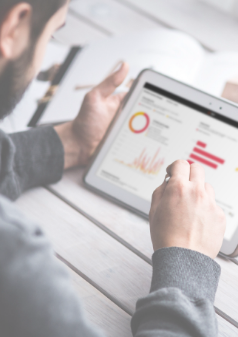
Metering & Monitoring for Corporate Sustainability Goals
Corporate sustainability has become a critical issue for businesses worldwide. Companies are recognizing the importance of reducing their carbon footprint and taking action to protect the environment. Buildings play a big role in this endeavor and making them greener is a complex road that requires planning and strategy.
For corporations with many locations, metering and monitoring energy use across their portfolio is typically the first step. In this blog post, we will explore the process of implementing metering and monitoring systems to help corporations define their sustainability goals effectively. We'll also delve into the challenges faced with traditional approaches and highlight the power of IoT-based systems in simplifying and optimizing this process.
Why Use Metering to Define Sustainability Goals?
Metering and monitoring involve tracking your buildings’ energy consumption and identifying areas to reduce energy use. Energy consumption meters record the amount of electricity or gas used in your buildings over time. Monitoring systems help companies to understand how energy is used in different parts of a building and identify areas where energy consumption is high. By analyzing this data, corporations can identify opportunities to reduce energy consumption and save costs.
The Standard Approach to Metering Across a Portfolio
Regardless of the selected vendors for this type of project, implementing meters across a portfolio follows a basic set of steps:
Install energy meters: You'll need to install energy meters in your building to monitor energy consumption. These meters can be installed at the main switchboard or at individual circuits to monitor specific areas of your building.
Implement monitoring systems: Monitoring systems can help you to identify areas where energy consumption is high. These systems can be simple, such as manually recording meter readings, or sophisticated, using data analytics and automated reporting.
Analyze data: Once you've collected data on your building's energy consumption, you'll need to analyze it to identify areas where energy is being wasted. This can involve looking at data for specific time periods or comparing data from different areas of your building.
Implement measures to reduce energy consumption: Based on your analysis, you'll need to implement measures to reduce energy consumption. This can involve measures such as switching to energy-efficient lighting, upgrading insulation, or installing solar panels.
Where Can it go Wrong?
Depending on the systems selected, this simple delineation of steps contains hidden complexities that can cause serious headaches. When it comes to metering and monitoring energy usage in buildings, traditional approaches often fall short in terms of efficiency, cost-effectiveness, and ease of implementation. Let's take a closer look at two commonly used options and the challenges they present.
Standalone, cloud-hosted metering and energy monitoring system
Traditional standalone systems dedicated to metering require separate infrastructure and cloud hosting, leading to increased costs and complexity. Integration with the Building Management System (BMS) often necessitates costly API integrations, making the process slow and laborious. Additionally, managing separate dashboards for each implementation adds to the expenses and creates inconsistencies across the portfolio.
Meters integrated into an existing BMS
Integrating meters into the BMS poses its own set of challenges. It requires extensive communication cabling or expensive network infrastructure, especially for larger facilities. Data modeling is typically left to the integrator, resulting in inconsistent or non-existent standards. Custom dashboards need to be created for each implementation, incurring additional costs and further complicating the process. On-premise data hosting and cloud hosting also add complexities, including the need for server maintenance and cybersecurity considerations. Managing multiple URLs/IP addresses for site monitoring can further hinder overall efficiency. Moreover, applying alerts across multiple sites or portfolios requires significant efforts from system integrators.

IoT in the Metering and Monitoring Process
In contrast to traditional approaches, IoT-based building management seamlessly integrates metering and monitoring, making the process more accessible and sophisticated. Here's how 75F simplifies the implementation of metering and monitoring, empowering corporations to define their sustainability goals effectively:
Native integration in the BMS
75F's system natively integrates metering and monitoring within the same platform as the BMS. This integrated approach eliminates the need for separate systems, reducing complexity and costs.
Cloud hosting and maintenance
The metering and monitoring capabilities are hosted on the 75F cloud, eliminating the need for on-premises data hosting and server maintenance. This streamlined approach simplifies operations and alleviates cybersecurity concerns.
Wi-Fi connectivity
75F's system leverages Wi-Fi connectivity, eliminating the requirement for complex network infrastructure. With a gateway to our cloud placed in each electrical room, 75F can save notable installation costs associated with communication cabling. This wireless solution also enables seamless and secure data transmission.
Consistent data modeling
With the use of Hayloft, 75F ensures consistent data modeling across the portfolio. This digital twin feature provides a standardized approach, simplifying data interpretation and analysis. Furthermore, users can easily build custom dashboards without relying on system integrators or custom graphics, saving time and money.
Scalability and cost effectiveness
75F's system makes it easy to add more meters in the future. This scalability enables corporations to expand their metering and monitoring capabilities effortlessly as their sustainability goals evolve. Additionally, the system's pricing structure ensures affordability and reduces the financial burden associated with implementing sustainability initiatives.
Streamlined portfolio management
75F provides a centralized web platform for portfolio-wide monitoring and account management. This means that corporations can conveniently monitor and manage energy usage across multiple sites from a single web portal. The streamlined portfolio management feature saves time and effort, allowing companies to efficiently track their sustainability progress.
Secure data sharing
75F's system offers secure options for sharing dashboards and data. Users can securely share dashboards publicly through embedded widgets, shared URLs, or downloadable formats such as Excel spreadsheets and PDFs. This functionality enables companies to collaborate with stakeholders, showcase their sustainability efforts, and foster transparency.
Simple and scalable alerts
75F's system empowers end users to set up custom alerts easily. The intuitive interface allows companies to create alert sequences and apply them across their entire portfolio within seconds. This scalable approach streamlines the process of implementing alerts, ensuring prompt notifications for any energy-related issues or deviations.
As companies strive to define their sustainability goals, it's essential to embrace modern and innovative solutions. With an IoT-based Building Management System, corporations can embark on their sustainability journey with confidence, knowing they have the tools and technology to monitor, optimize, and achieve their energy efficiency targets.











